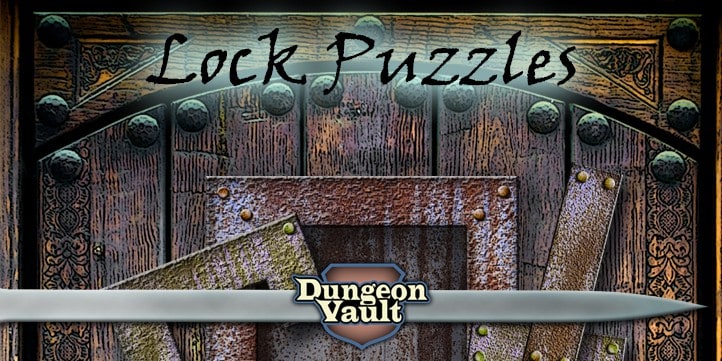
There is something about graveyards that just screams Dungeons and Dragons. Maybe it’s all the undead in D&D. Maybe it’s all the dungeons that fit so nicely beneath a graveyard. In any case, it just works. But what about using puzzles in a graveyard? Well, that also works great. So here are a couple of graveyard puzzle ideas to that’ll send a chill down your players’ spines.
Puzzle idea 1: Finding the right headstone
The first thing that comes to mind when you’re in a graveyard is to read the headstones. Just finding the correct grave can be a bit of a puzzle. And we can use that to build a bigger puzzle. For instance, what if the players only have pieces of information about the deceased they are looking for?
- They know the deceased died during the Cellantian Wars which lasted from 836 until 844.
- They know the deceased wasn’t an elf.
- They know the deceased was highborn.
The headstones each provide bits of information and through the process of deduction players can narrow it down to one headstone and find out the deceased name. This setup is a lot like the classic ‘who is it’ game.
But you don’t have to literally write all the information on each headstone. A highborn deceased would have a more luxurious headstone. Or maybe a ghost sitting on a grave could provide a clue. Also the final information doesn’t have to be learning the name of the deceased. Players could also be looking for the grave where a treasure is buried. Or one that leads to a secret underground catacomb.
Puzzle idea 2: Using a single headstone as a puzzle
A different graveyard puzzle use is to just place one puzzle on a single headstone. Maybe a message is written in a language the players must decipher. And if they’re successful a ghost appears giving them the information they need. The player’s handbook has a couple of scripts you could use.
You can combine this puzzle with idea nr 1. Maybe elves, dwarfs, dragonborn, and humans were all buried in this graveyard and each headstone naturally has its own script.
Puzzle idea 3: Using mausoleums
A mausoleum is a small building for the above ground burial of both caskets and cremation urns. The inside of the mausoleum could have a wall or floor with tile work depicting angels and demons locked in an eternal struggle. I’ve created a puzzle revolving around that theme aptly named: Angels and Demons Puzzles.
With this puzzle, players have to place the tiles in the correct pattern to solve the puzzle. Doing so could put a spirit to rest, open a doorway to an underground catacomb, or anything else you wish to happen. I’ve found it works very well with a graveyard thematically.
The pack comes with 25 puzzles, so you can lay out multiple puzzles in mausoleums or just place increasingly difficult angel and demon puzzles along their route.
Puzzle idea 4: Entering the catacombs
Catacombs. Somehow graveyard adventures inevitably seem to lead to this underground collection of skeletons – and who knows what else? Catacombs are also a cultist’s favourite hideout for reasons beyond my comprehension.
In any case, they are ideal for puzzles. You can easily change the many winding and twisting pathways of a catacomb into a puzzle. For this, I like to use dungeon puzzles.
Dungeon puzzles changes an entire dungeon (or catacomb) into a puzzle. Given only a fragmented map, players have to figure out the layout of the catacomb before they can enter the catacombs.
This pack also comes with 25 puzzles. So there plenty of catacombs to explore. But really, you can create an infinite amount of puzzles with this pack. And the tile pieces work for laying out dungeons or any kind.
Puzzle idea 5: The closed casket
Now why would anyone wish to seal a casket with a complicated puzzle lock that is just begging to be opened by the PCs? What could go wrong? With this puzzle players find several iron slots on different sides of a sinister looking casket. These slots can hold iron keys the PCs have found in the catacombs. If they can puzzle out how to place the keys, the casket opens and surely good and safe things will happen. vampires are greatfull that way.
For closing things I like to use lock puzzles. You can simply drop a number of slots onto any object to seal it, and give players key pieces to try and crack the lock. The more complex the lock, the more slots you place on it. For DMs this puzzle setup is very easy. Not so much for your players though. (evil grin).
Final tip
With graveyard puzzles using undead is almost a given. Combining undead with your puzzles is a great way to add time pressure. Zombies, for instance, could slowly be crawling out of their graves as players try to figure out the next step of a puzzle. And opening the wrong casket might just awaken a vampire. Whoever said puzzles aren’t nerve-wracking hasn’t had a zombie clawing at their ankles!
If you like these puzzles be sure to check out the vault bundle. It has my complete collection of puzzles for roleplaying games in tabletop and virtual tabletop format.
By Paul Camp
Cover image: Magic the Gathering





